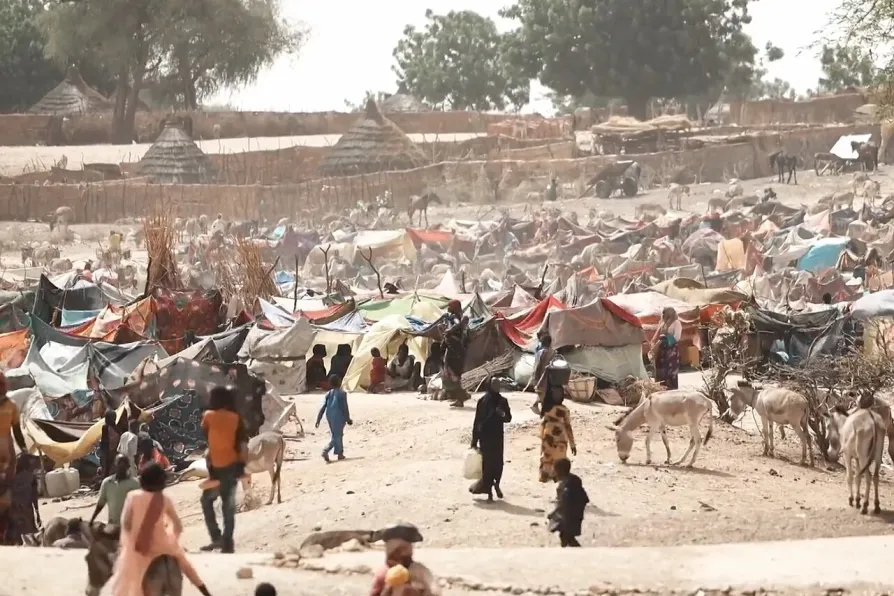RAMZY BAROUD offers six reasons why Netanyahu is prolonging conflict in the Middle East
The spectre of ethnic cleansing looms over hundreds of thousands trapped without food, water, or medicines in the North Darfur state’s besieged capital, El Fasher, writes PAVAN KULKARNI

 A Chadian camp for displaced people who fled violence in Darfur at the Chad-Sudan border, 2023
A Chadian camp for displaced people who fled violence in Darfur at the Chad-Sudan border, 2023
NEARLY half a million people were forced to flee from North Darfur state’s capital, El Fasher, and the nearby Zamzam camp for displaced people in just the two months of April and May, the UN secretary-general’s spokesperson, Stephane Dujarric, said in a press briefing on Monday July 7.
North Darfur is the only one of the five states where the Sudanese Armed Forces (SAF) have retained a foothold in war-torn Sudan’s vast western region of Darfur, overrun by its rival, the paramilitary Rapid Support Force (RSF), within six months of the war’s start in April 2023.
Moving against this last holdout, the RSF laid siege in May 2024 on El Fasher, where the SAF has a base, and the Zamzam camp on its outskirts, where some of the local self-defence units allied with the SAF are positioned.
“People are not only caught in indiscriminate heavy fighting between” the two warring forces, but are also being “actively targeted by the RSF and its allies, notably on the basis of their ethnicity,” Michel Olivier Lacharite, MSF head of emergencies, said on July 3.
SAF created the RSF in Darfur
The RSF was coalesced in 2013 from the militias the SAF had spawned from Arabic-speaking nomadic communities to perpetrate mass atrocities on the regional-language-speaking groups of sedentary farmers that supported the rebel groups during the Darfur civil war in the 2000s.
The partnership between SAF and the RSF lasted a decade, during which they seized power together to form a military junta in 2019, when mass pro-democracy protests forced the ouster of Omar al-Bashir after a 30-year-long dictatorship.
The duo deployed its troops to jointly repress the militant protests that continued until April 15 2023, when the intensifying power struggle within the junta between the two forces crossed the Rubicon, mobilising their forces against each other and hurling the country into a civil war.
Displaced people under attack
Now continuing into its third year, the civil war has claimed an estimated 150,000 lives and displaced nearly 13 million people, unleashing in this poor north African country the world’s worst displacement crisis.
Over three million of the displaced have fled to other countries as refugees. An estimated 8.6 million have remained as internally displaced people (IDPs). Darfur, which already had almost 3.1 million IDPs from the regional civil war in the 2000s, was among the worst-affected regions by this new war.
The RSF manoeuvred quickly to take control over this region, starting with West Darfur, where it committed ethnically targeted massacres in June 2023 against the Masalit community, most of whom were displaced in the Darfur civil war. Ethnic cleansing of this community from West Darfur was nearly complete by November that year.
By then, the RSF had taken over most of the region, with North Darfur as the SAF’s only holdout. Members of the state’s Zaghawa community, which had until then remained neutral, volunteered in large numbers to form self-defence units that aligned themselves with the SAF.
“In light of the ethnically motivated mass atrocities committed on the Masalit in West Darfur… MSF fears such a scenario will be repeated in El Fasher — notably because witnesses report that RSF soldiers spoke of plans to ‘clean El Fasher’ of its non-Arab, and especially Zaghawa, community,” MSF said in a report released on July 3.
Titled Besieged, attacked, starved: Mass atrocities in El Fasher, the report added: “Aside from the direct violence exerted on civilians, residents from El Fasher and surrounding areas [also] have been prevented from meeting their basic needs.”
Famine
The RSF’s siege since last May has cut off the city and its surrounding localities from supplies. Its markets have been repeatedly bombed by both sides. At the Zamzam camp located 17km south of El Fasher, a famine was declared in August 2024.
Among the largest IDP camps in the country, it was already sheltering about 350,000 displaced people from the Darfur civil war. With new displacements from this intra-junta civil war, IDPs nearly doubled in Zamzam. Its meagre resources in the form of aid were already stretched when its supply was cut off by the RSF’s siege in May 2024.
“When fighting erupted in Zamzam in December 2024 and then intensified at the end of January and in February 2025, the camp was hosting … up to 700,000,” MSF’s report added.
Most of them had to flee again, for the second, even third time, after the RSF’s large-scale ground offensive this April, displacing over 400,000 in three weeks, according to the International Organisation for Migration (IOM).
“A large proportion of the population fled to El Fasher, where they remained trapped, out of reach of humanitarian aid and exposed to attacks and further mass violence,” the report warns.
No escape for the Zaghawa community
Over 68,000 others have fled across the western border to Chad, according to the UN Refugee Agency (UNHCR). No-one identified as Zaghawa was let through the RSF checkpoints, multiple survivors told the MSF. “They would only let mothers with small children under the age of five through,” said one of the refugees interviewed in Chad.
“Other children and adult men didn’t go through. Males over fifteen can hardly cross the border [into Chad]. They take them, they push them aside, and then we only hear a noise, gunshots … Fifty families came along with me. Not even one boy of 15 years old or above.. [is] among us” in Chad.
“The number of people killed and injured” in the RSF’s offensive on Zamzam is “unknown,” the report said, adding “with no functional hospital within the camp, most of the wounded had no access to life-saving medical assistance.”
“Access to healthcare has been rendered near impossible, as most healthcare infrastructure has been partially or completely damaged.” MSF’s own medical facilities have been attacked over a dozen times since last May.
This article is republished from peoplesdispatch.org.

As the UAE-backed RSF carries out drone strikes on humanitarian infrastructure in war-torn Sudan, the US sells more weapons to the UAE, writes PAVAN KULKARNI

Keir Starmer’s £120 million to Sudan cannot cover the government’s complicity in the RSF genocide or atone for the long shadow of British colonialism and imperialism, writes CLAUDIA WEBBE











